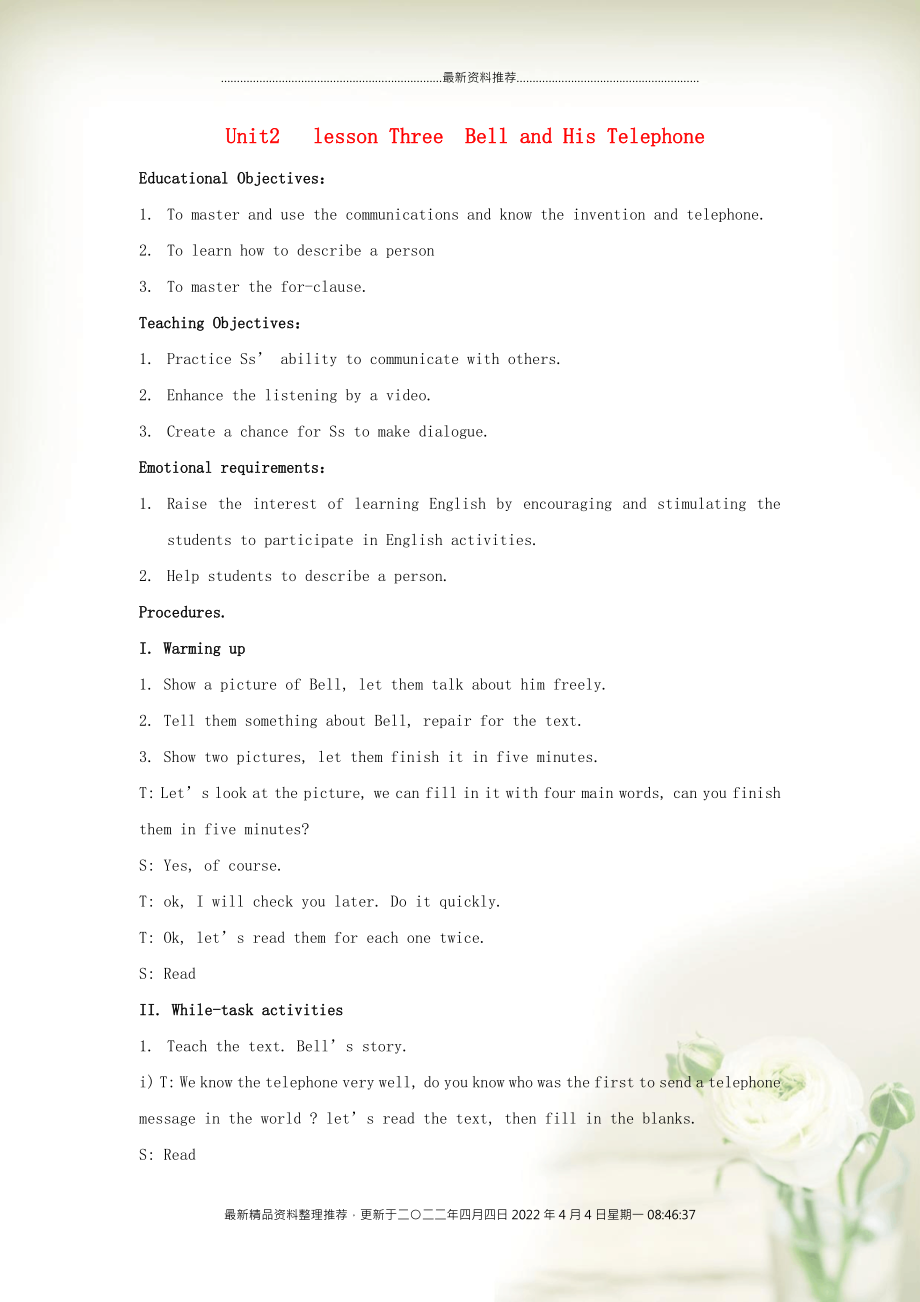《【金識(shí)源】九年級(jí)英語(yǔ)上冊(cè) Unit 2 Lesson3 Bell and His Telephone教學(xué)設(shè)計(jì)1 上海新世紀(jì)版》由會(huì)員分享,可在線閱讀�,更多相關(guān)《【金識(shí)源】九年級(jí)英語(yǔ)上冊(cè) Unit 2 Lesson3 Bell and His Telephone教學(xué)設(shè)計(jì)1 上海新世紀(jì)版(3頁(yè)珍藏版)》請(qǐng)?jiān)谘b配圖網(wǎng)上搜索。
1�、最新資料推薦 Unit2 lesson Three Bell and His TelephoneEducational Objectives:1. To master and use the communications and know the invention and telephone.2. To learn how to describe a person3. To master the for-clause.Teaching Objectives:1. Practice Ss ability to communicate with others.2. Enhance the lis
2、tening by a video.3. Create a chance for Ss to make dialogue.Emotional requirements:1. Raise the interest of learning English by encouraging and stimulating the students to participate in English activities.2. Help students to describe a person.Procedures.I. Warming up1. Show a picture of Bell, let
3�、them talk about him freely.2. Tell them something about Bell, repair for the text.3. Show two pictures, let them finish it in five minutes.T: Lets look at the picture, we can fill in it with four main words, can you finish them in five minutes?S: Yes, of course.T: ok, I will check you later. Do it q
4、uickly.T: Ok, lets read them for each one twice.S: Read II. While-task activities1. Teach the text. Bells story.i) T: We know the telephone very well, do you know who was the first to send a telephone message in the world ? lets read the text, then fill in the blanks.S: Read Show the answers to them
5�����、 , let them check themselves. Britain Moved to Canada 1871, Settled in Sent the worlds first telephone message 1877, established American citizen Died ii) Do a pair work to ask and answer questions about Bell. 1.Do you know who invented the telephone? 2. why did he have a keen desire to help the dea
6��、f 3.What has his invention brought us? 4.What has the “electrical speech machine” paved the way for?2. Tell the compound sentence (for)1) Ask one of pair to read the short talk.2) Repeat the talk by numbers.T: we can find the using of for.關(guān)于 for:是并列連詞,其余三者為從屬連詞 表原因時(shí)提供補(bǔ)充說(shuō)明�,for 分句應(yīng)后置,有時(shí)可與because替換 還可表
7��、示對(duì)前面內(nèi)容的解釋或推斷比較��,不可與Because替換.Do some exercises to consolidate the using.3. T: How do you communicate with your friends?S: usually communicate by phone, for.T: I dont agree./ Me, too.T: Ok, Do you know e-mail?S: Its .T: Ok, lets talk about it by reading a passage. And then answer the questions on the
8��、notebook.III. Post-task activities To make a short dialogue and ask some Ss to act it out using the knowledge they learned today.IV. Homework1. Recite the sentence patterns2. Write a short essay “ Talk about the differences between the phones and e-mails.”板書(shū)設(shè)計(jì):Unit2 lesson Three Bell and His Telepho
9、nesettle citizen electrical keen desire 1.Do you know who invented the telephone? 2. why did he have a keen desire to help the deaf 3.What has his invention brought us? 4.What has the “electrical speech machine” paved the way for?關(guān)于 for:是并列連詞, 為從屬連詞�����,因?yàn)?�,由于的緣? 表原因時(shí)提供補(bǔ)充說(shuō)明�����,for 分句應(yīng)后置�,有時(shí)可與because替換 還可表示對(duì)前面內(nèi)容的解釋或推斷比較�,不可與Because替換:教學(xué)反思:通過(guò)本課教授,發(fā)現(xiàn)積極創(chuàng)設(shè)情境�,會(huì)極大的激發(fā)學(xué)生學(xué)習(xí)欲望和積極性,本課我主要采用了任務(wù)型教學(xué)法��,比單純教師講授更有效果�,今后還會(huì)多多采用。最新精品資料整理推薦�,更新于二二二年四月四日2022年4月4日星期一08:46:37
 【金識(shí)源】九年級(jí)英語(yǔ)上冊(cè) Unit 2 Lesson3 Bell and His Telephone教學(xué)設(shè)計(jì)1 上海新世紀(jì)版
【金識(shí)源】九年級(jí)英語(yǔ)上冊(cè) Unit 2 Lesson3 Bell and His Telephone教學(xué)設(shè)計(jì)1 上海新世紀(jì)版

